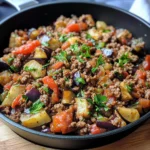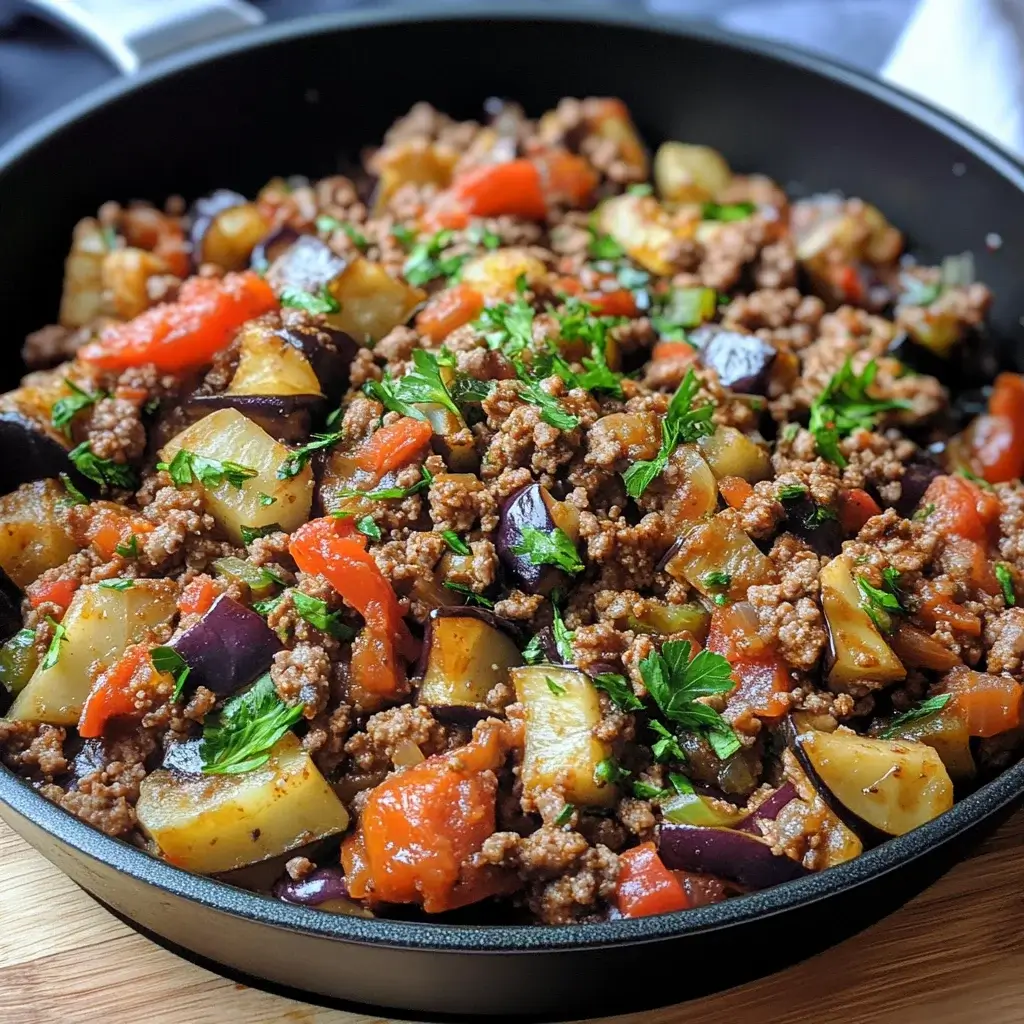The first time I made this Eggplant and Ground Beef Skillet, I wasn’t sure what to expect. Eggplant can be tricky, sometimes turning out bitter or spongy, and I worried if the flavors would meld correctly with the savory ground beef. But let me tell you, the aroma that filled my kitchen as it simmered was the first sign that something special was happening. Rich, savory notes of beef mingled with the earthiness of eggplant and the bright tang of tomatoes. When we finally sat down to eat, scooping generous portions over fluffy couscous, it was an instant hit. My partner, usually reserved in his praise, declared it “restaurant-quality,” and even my notoriously picky teenager went back for seconds, mumbling something about the eggplant being “surprisingly good.” Since then, this skillet has become a staple in our weeknight rotation. It’s that perfect combination of comforting, flavorful, and relatively easy to whip up after a busy day. The eggplant transforms, becoming tender and soaking up the rich, meaty sauce beautifully. It feels wholesome yet deeply satisfying, proving that simple ingredients, cooked with a little care, can create truly memorable meals. This dish isn’t just food; it’s comfort in a pan, a reliable crowd-pleaser that brings warmth and flavor to the dinner table every single time.
Ingredients
- 1 large Globe Eggplant (about 1.5 lbs): Choose a firm, glossy eggplant, heavy for its size. This is the star vegetable, providing a creamy texture when cooked.
- 1 tbsp Salt: Used primarily for drawing excess moisture and bitterness from the eggplant.
- 2 tbsp Olive Oil (divided): A good quality extra virgin olive oil adds flavour; used for sautéing.
- 1 lb Lean Ground Beef (90/10 or leaner): Provides the savory, protein-rich base of the dish. Leaner beef means less grease to drain.
- 1 large Yellow Onion (finely chopped): Builds the aromatic foundation of the sauce.
- 3-4 cloves Garlic (minced): Adds pungent depth and essential flavor. Adjust quantity to your liking.
- 1 tsp Dried Oregano: Contributes a classic Mediterranean, earthy aroma.
- 1 tsp Smoked Paprika: Adds a subtle smokiness and beautiful color.
- 1/2 tsp Cumin Powder: Provides warm, earthy notes that complement the beef and eggplant.
- 1/4 tsp Red Pepper Flakes (optional): For a gentle touch of heat. Add more or less depending on your preference.
- 1 (28-ounce) can Crushed Tomatoes: Forms the bulk of the sauce, offering acidity and richness. Fire-roasted tomatoes can add extra depth.
- 1 cup Beef Broth (low sodium): Adds liquid for simmering and deepens the savory flavor profile.
- 1 tbsp Tomato Paste: Concentrated tomato flavor that adds intensity and helps thicken the sauce.
- Salt and Black Pepper: To taste, for seasoning throughout the cooking process.
- Fresh Parsley or Basil (chopped, for garnish): Adds a pop of freshness and color at the end.
- Optional: Feta Cheese or Parmesan Cheese (crumbled or grated, for serving): Provides a salty, tangy, or nutty finish.
Instructions
- Prepare the Eggplant: Wash the eggplant thoroughly. Trim off the stem end. Cut the eggplant into 1-inch cubes. Place the cubes in a colander set over a bowl or in the sink. Sprinkle generously with the 1 tablespoon of salt, tossing to coat evenly. Let the eggplant sit for 30-60 minutes. This process, called disgorging, helps draw out excess moisture and potential bitterness. After resting, rinse the eggplant cubes thoroughly under cold running water to remove the salt, then pat them completely dry with paper towels. Ensuring they are dry is crucial for proper browning.
- Brown the Eggplant (Optional but Recommended): Heat 1 tablespoon of olive oil in a large, deep skillet or Dutch oven over medium-high heat. Add half of the dried eggplant cubes in a single layer (work in batches if necessary to avoid overcrowding the pan). Cook, turning occasionally, until the eggplant is lightly browned and slightly tender, about 5-7 minutes per batch. Remove the browned eggplant from the skillet and set aside on a plate. Add the remaining 1 tablespoon of olive oil and brown the second batch of eggplant cubes. Set aside with the first batch. Note: Eggplant absorbs oil quickly; add a touch more oil only if absolutely necessary.
- Cook the Aromatics: If needed, add a tiny bit more olive oil to the same skillet (there might be enough residual from the eggplant). Reduce the heat to medium. Add the finely chopped yellow onion and cook, stirring occasionally, until softened and translucent, about 5-7 minutes. Add the minced garlic, dried oregano, smoked paprika, cumin powder, and optional red pepper flakes. Cook for another 1-2 minutes, stirring constantly, until the spices are fragrant. Be careful not to burn the garlic or spices.
- Brown the Ground Beef: Increase the heat to medium-high. Add the lean ground beef to the skillet. Break it apart with a spoon and cook, stirring frequently, until it’s browned and cooked through, about 8-10 minutes. If using beef with higher fat content, carefully drain off any excess grease from the skillet at this stage.
- Build the Sauce: Stir the tomato paste into the ground beef mixture and cook for 1 minute, allowing it to caramelize slightly – this enhances its flavor. Pour in the crushed tomatoes and the beef broth. Stir everything together, scraping up any browned bits (fond) from the bottom of the skillet, as these add significant flavor.
- Simmer: Bring the sauce mixture to a gentle simmer. Season with salt and black pepper to taste. Remember that the eggplant was salted initially (though rinsed) and the broth may contain sodium, so season cautiously at first.
- Combine and Finish: Gently return the browned eggplant cubes to the skillet. Stir carefully to coat the eggplant with the sauce. Reduce the heat to low, cover the skillet, and let it simmer for 20-30 minutes, or until the eggplant is very tender and has absorbed the flavors of the sauce. Stir occasionally to prevent sticking. If the sauce seems too thick, you can add a splash more beef broth or water. If it seems too thin, remove the lid for the last 5-10 minutes of simmering to allow some liquid to evaporate.
- Final Seasoning and Garnish: Taste the skillet mixture one last time and adjust seasonings (salt, pepper, red pepper flakes) if needed. Remove from heat. Stir in most of the fresh chopped parsley or basil, reserving some for garnish.
- Serve: Ladle the Eggplant and Ground Beef Skillet into bowls. Garnish with the remaining fresh herbs and a sprinkle of optional feta or Parmesan cheese, if desired.
Nutrition Facts
(Approximate values based on a serving size of 1/6th of the recipe)
- Servings: 6
- Calories per serving: Approximately 350-450 kcal (This can vary based on the leanness of the beef and the amount of oil used).
- Protein: Around 25-30g. Crucial for muscle maintenance, satiety, and overall body function, primarily from the ground beef.
- Fiber: Approximately 8-10g. Significant contribution from the eggplant and tomatoes, supporting digestive health and fullness.
- Net Carbohydrates: Roughly 15-20g. Relatively moderate, making it adaptable for lower-carb approaches depending on serving choices (calculated as total carbs minus fiber).
- Fat: Approximately 20-25g. Varies significantly with beef choice and oil usage; includes healthier unsaturated fats from olive oil alongside saturated fats from beef.
Disclaimer: Nutritional information is an estimate only and can vary depending on specific ingredients used.
Preparation Time
This satisfying Eggplant and Ground Beef Skillet typically requires about 20-25 minutes of active preparation time (chopping vegetables, browning ingredients) and 45-60 minutes of cooking time (including sautéing, browning, and simmering). The optional but recommended step of salting the eggplant adds an extra 30-60 minutes of inactive resting time. Therefore, the total time from start to finish is approximately 1 hour 30 minutes to 2 hours, but much of this is hands-off simmering or resting time.
How to Serve
This versatile Eggplant and Ground Beef Skillet can be served in numerous delicious ways. Here are some popular options:
- Over Grains:
- Fluffy Rice: Serve atop a bed of simple steamed white or brown rice to soak up the rich sauce. Basmati or Jasmine rice works beautifully.
- Couscous: Light and fluffy couscous (regular or pearl/Israeli) provides a lovely textural contrast. Prepare according to package directions, perhaps adding a knob of butter or a drizzle of olive oil.
- Quinoa: A nutritious, protein-packed grain that pairs well with the savory flavors.
- Bulgur Wheat: Offers a slightly nutty flavor and chewy texture, common in Mediterranean cuisine.
- With Pasta or Noodles:
- Pasta: Toss with sturdy pasta shapes like rigatoni, penne, or pappardelle for a hearty, Italian-inspired meal reminiscent of a Bolognese with eggplant.
- Egg Noodles: Wide egg noodles provide a comforting, homestyle base.
- Low-Carb Options:
- Cauliflower Rice: A popular low-carb alternative to traditional rice.
- Zucchini Noodles (Zoodles): Serve over lightly sautéed or raw zucchini noodles for a veggie-packed meal.
- Spaghetti Squash: Roasted spaghetti squash strands make a fantastic, low-carb “pasta” base.
- On its Own: Enjoy it straight from the bowl as a satisfying, low-carb stew.
- Accompaniments:
- Crusty Bread: Essential for mopping up every last bit of the delicious sauce. Garlic bread or a simple baguette works perfectly.
- Pita Bread: Warm pita bread is great for scooping.
- Polenta: Creamy polenta (either soft or grilled slices) provides a wonderful contrast in texture and flavor.
- Toppings & Garnishes:
- Cheese: Crumbled feta (tangy), grated Parmesan (nutty), or even a dollop of ricotta adds creaminess and extra flavor.
- Fresh Herbs: Extra chopped parsley, basil, mint, or even dill brightens the dish.
- Yogurt or Sour Cream: A dollop of plain Greek yogurt or sour cream adds a cooling, tangy counterpoint.
- Toasted Pine Nuts: Adds a delightful crunch and nutty flavor.
- A Drizzle of Olive Oil: A finishing drizzle of high-quality extra virgin olive oil enhances the richness.
Additional Tips
- Choosing the Right Eggplant: Look for eggplants that are firm, smooth, and glossy with a vibrant deep purple color (for globe variety). They should feel heavy for their size, indicating freshness and moisture content. Avoid eggplants with soft spots, blemishes, or wrinkled skin. Smaller to medium-sized eggplants often have fewer seeds and can be less bitter.
- The Importance of Salting (Disgorging): While modern eggplant varieties are often less bitter, salting still serves the crucial purpose of drawing out excess moisture. This prevents the eggplant from becoming soggy and helps it brown better, resulting in a creamier, more concentrated texture in the final dish rather than a watery one. Don’t skip this step if you want the best texture. Remember to rinse thoroughly and pat completely dry.
- Don’t Overcrowd the Pan: When browning the eggplant (and later the beef), ensure the pieces are in a single layer with some space between them. Overcrowding lowers the pan temperature, causing the ingredients to steam rather than brown, which diminishes flavor development and can lead to sogginess. Work in batches if your skillet isn’t large enough.
- Control the Oil: Eggplant acts like a sponge and can soak up a surprising amount of oil. Use just enough oil to facilitate browning. If the pan becomes too dry while browning eggplant, add oil sparingly, perhaps just a teaspoon at a time. Using non-stick cookware can help minimize the amount of oil needed. The initial browning step is optional; you can add the raw (salted, rinsed, dried) eggplant directly to the sauce to simmer, but it won’t have the same depth of flavor or hold its shape quite as well.
- Develop Flavor Layers: Don’t rush the initial steps. Properly softening the onions releases their sweetness. Toasting the garlic and spices for a minute until fragrant blooms their flavors. Browning the beef well creates a savory foundation. Scraping up the browned bits (fond) from the bottom of the pan when adding liquids incorporates concentrated flavor into the sauce. Each step builds upon the last.
- Adjust Sauce Consistency: Simmering time affects the final consistency. If your sauce seems too thin towards the end of cooking, remove the lid and let it simmer uncovered for the last 5-10 minutes to allow excess liquid to evaporate and the sauce to thicken. Conversely, if it becomes too thick, stir in a splash of additional beef broth or water until it reaches your desired consistency.
- Make Ahead & Storage: This Eggplant and Ground Beef Skillet tastes even better the next day as the flavors meld and deepen. Prepare it a day in advance for easy meal prep. Store leftovers in an airtight container in the refrigerator for up to 3-4 days. Reheat gently on the stovetop over low heat, adding a splash of broth or water if needed, or reheat in the microwave. Freezing is possible, though the texture of the eggplant may become slightly softer upon thawing. Thaw in the refrigerator overnight before reheating.
- Spice It Up or Down: Customize the heat level easily. For more spice, increase the amount of red pepper flakes, add a pinch of cayenne pepper, or include a finely chopped jalapeño or serrano pepper along with the onions. For a milder dish, omit the red pepper flakes entirely. Consider adding other complementary spices like a pinch of cinnamon or allspice for a more distinctively Mediterranean or Middle Eastern flair.
FAQ
- Q: My eggplant turned out bitter. What went wrong?
- A: Bitterness in eggplant can occasionally occur, especially in older or larger specimens with lots of seeds. The salting (disgorging) process is specifically designed to minimize this by drawing out bitter juices along with excess moisture. Ensure you salted the eggplant adequately (30-60 minutes), rinsed it thoroughly to remove the salt, and patted it completely dry. Using fresh, smaller-to-medium eggplants can also help reduce the chances of bitterness.
- Q: Can I use a different type of ground meat?
- A: Absolutely! This recipe is very adaptable. Ground turkey, ground chicken, or ground lamb would all work beautifully as substitutes for ground beef. Ground lamb, in particular, would lend a distinctly Mediterranean flavor profile that pairs exceptionally well with eggplant and oregano. Adjust cooking times slightly if needed, ensuring the poultry is cooked through.
- Q: How can I make this recipe vegetarian or vegan?
- A: To make it vegetarian, omit the ground beef and substitute with about 1.5 cups of cooked brown or green lentils, crumbled firm tofu or tempeh, or plant-based ground “meat.” You’ll also need to swap the beef broth for vegetable broth. Sauté the plant-based protein after the onions and garlic, then proceed. For a vegan version, ensure your broth is vegan and omit any cheese garnish, or use a vegan alternative. Adding extra vegetables like mushrooms or bell peppers can also enhance the vegetarian version.
- Q: My eggplant became mushy and disintegrated into the sauce. How can I prevent this?
- A: Several factors contribute to this. Firstly, ensure you didn’t overcook it; check for tenderness periodically during the final simmer. Secondly, the initial browning step helps the eggplant hold its shape better than adding it raw. Thirdly, cutting the eggplant into slightly larger cubes (e.g., 1.25 inches) can help. Finally, be gentle when stirring after adding the eggplant back to the sauce. A little softening is expected and desirable, but complete disintegration usually means it was overcooked or wasn’t browned first.
- Q: Can I add other vegetables to this skillet?
- A: Yes, this is a great base for adding more veggies! Chopped bell peppers (any color), zucchini or yellow squash (added during the last 15 minutes of simmering), mushrooms (sautéed with the onions), or even a can of drained chickpeas (added with the eggplant) would be delicious additions. Adjust simmering time as needed for the added vegetables to become tender.
- Q: Is this recipe low-carb or keto-friendly?
- A: Eggplant and tomatoes do contain carbohydrates, but this dish can be part of a low-carb diet depending on your specific carb goals and serving size. A standard serving (as estimated above) has around 15-20g net carbs. To make it more keto-friendly, ensure you use fatty ground beef, be generous with olive oil, potentially reduce the amount of tomato or use a lower-carb tomato product, and serve it on its own or with very low-carb accompaniments like cauliflower rice or zoodles, avoiding grains, pasta, or bread. Always check specific ingredient carb counts.
- Q: What’s the difference between using crushed tomatoes and diced tomatoes?
- A: Crushed tomatoes provide a smoother, thicker sauce base, integrating well into the dish. Diced tomatoes will result in a chunkier sauce with distinct pieces of tomato. While diced tomatoes can be used (perhaps pulsed briefly in a blender if you prefer less chunkiness), crushed tomatoes generally yield a texture closer to a traditional stew or ragu, which works particularly well in this recipe for coating the eggplant and beef evenly. Fire-roasted crushed tomatoes add an extra layer of smoky flavor.
- Q: How do I prevent the eggplant from soaking up too much oil during browning?
- A: This is a common challenge! Use only the minimum amount of oil needed to prevent sticking (1 tbsp per batch is usually sufficient, especially in a non-stick pan). Ensure the pan and oil are properly heated before adding the eggplant; hot oil is absorbed less readily than warm oil. Don’t overcrowd the pan, as this lowers the temperature. Patting the eggplant completely dry after rinsing is critical – wet eggplant will absorb more oil and splatter. Alternatively, you can roast the salted eggplant cubes in the oven (tossed with a little oil) at 400°F (200°C) until tender and lightly browned instead of pan-frying.

Eggplant and Ground Beef Skillet
Ingredients
- 1 large Globe Eggplant (about 1.5 lbs): Choose a firm, glossy eggplant, heavy for its size. This is the star vegetable, providing a creamy texture when cooked.
- 1 tbsp Salt: Used primarily for drawing excess moisture and bitterness from the eggplant.
- 2 tbsp Olive Oil (divided): A good quality extra virgin olive oil adds flavour; used for sautéing.
- 1 lb Lean Ground Beef (90/10 or leaner): Provides the savory, protein-rich base of the dish. Leaner beef means less grease to drain.
- 1 large Yellow Onion (finely chopped): Builds the aromatic foundation of the sauce.
- 3–4 cloves Garlic (minced): Adds pungent depth and essential flavor. Adjust quantity to your liking.
- 1 tsp Dried Oregano: Contributes a classic Mediterranean, earthy aroma.
- 1 tsp Smoked Paprika: Adds a subtle smokiness and beautiful color.
- 1/2 tsp Cumin Powder: Provides warm, earthy notes that complement the beef and eggplant.
- 1/4 tsp Red Pepper Flakes (optional): For a gentle touch of heat. Add more or less depending on your preference.
- 1 (28-ounce) can Crushed Tomatoes: Forms the bulk of the sauce, offering acidity and richness. Fire-roasted tomatoes can add extra depth.
- 1 cup Beef Broth (low sodium): Adds liquid for simmering and deepens the savory flavor profile.
- 1 tbsp Tomato Paste: Concentrated tomato flavor that adds intensity and helps thicken the sauce.
- Salt and Black Pepper: To taste, for seasoning throughout the cooking process.
- Fresh Parsley or Basil (chopped, for garnish): Adds a pop of freshness and color at the end.
- Optional: Feta Cheese or Parmesan Cheese (crumbled or grated, for serving): Provides a salty, tangy, or nutty finish.
Instructions
- Prepare the Eggplant: Wash the eggplant thoroughly. Trim off the stem end. Cut the eggplant into 1-inch cubes. Place the cubes in a colander set over a bowl or in the sink. Sprinkle generously with the 1 tablespoon of salt, tossing to coat evenly. Let the eggplant sit for 30-60 minutes. This process, called disgorging, helps draw out excess moisture and potential bitterness. After resting, rinse the eggplant cubes thoroughly under cold running water to remove the salt, then pat them completely dry with paper towels. Ensuring they are dry is crucial for proper browning.
- Brown the Eggplant (Optional but Recommended): Heat 1 tablespoon of olive oil in a large, deep skillet or Dutch oven over medium-high heat. Add half of the dried eggplant cubes in a single layer (work in batches if necessary to avoid overcrowding the pan). Cook, turning occasionally, until the eggplant is lightly browned and slightly tender, about 5-7 minutes per batch. Remove the browned eggplant from the skillet and set aside on a plate. Add the remaining 1 tablespoon of olive oil and brown the second batch of eggplant cubes. Set aside with the first batch. Note: Eggplant absorbs oil quickly; add a touch more oil only if absolutely necessary.
- Cook the Aromatics: If needed, add a tiny bit more olive oil to the same skillet (there might be enough residual from the eggplant). Reduce the heat to medium. Add the finely chopped yellow onion and cook, stirring occasionally, until softened and translucent, about 5-7 minutes. Add the minced garlic, dried oregano, smoked paprika, cumin powder, and optional red pepper flakes. Cook for another 1-2 minutes, stirring constantly, until the spices are fragrant. Be careful not to burn the garlic or spices.
- Brown the Ground Beef: Increase the heat to medium-high. Add the lean ground beef to the skillet. Break it apart with a spoon and cook, stirring frequently, until it’s browned and cooked through, about 8-10 minutes. If using beef with higher fat content, carefully drain off any excess grease from the skillet at this stage.
- Build the Sauce: Stir the tomato paste into the ground beef mixture and cook for 1 minute, allowing it to caramelize slightly – this enhances its flavor. Pour in the crushed tomatoes and the beef broth. Stir everything together, scraping up any browned bits (fond) from the bottom of the skillet, as these add significant flavor.
- Simmer: Bring the sauce mixture to a gentle simmer. Season with salt and black pepper to taste. Remember that the eggplant was salted initially (though rinsed) and the broth may contain sodium, so season cautiously at first.
- Combine and Finish: Gently return the browned eggplant cubes to the skillet. Stir carefully to coat the eggplant with the sauce. Reduce the heat to low, cover the skillet, and let it simmer for 20-30 minutes, or until the eggplant is very tender and has absorbed the flavors of the sauce. Stir occasionally to prevent sticking. If the sauce seems too thick, you can add a splash more beef broth or water. If it seems too thin, remove the lid for the last 5-10 minutes of simmering to allow some liquid to evaporate.
- Final Seasoning and Garnish: Taste the skillet mixture one last time and adjust seasonings (salt, pepper, red pepper flakes) if needed. Remove from heat. Stir in most of the fresh chopped parsley or basil, reserving some for garnish.
- Serve: Ladle the Eggplant and Ground Beef Skillet into bowls. Garnish with the remaining fresh herbs and a sprinkle of optional feta or Parmesan cheese, if desired.
Nutrition
- Serving Size: one normal portion
- Calories: 450
- Fat: 25g
- Carbohydrates: 20g
- Fiber: 10g
- Protein: 30g






